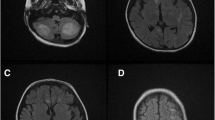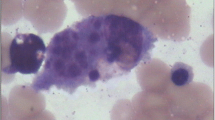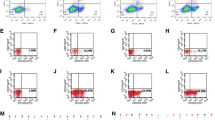Abstract
Aggressive natural killer cell leukemia (ANKL) is a rare neoplasm characterized by the systemic infiltration of Epstein–Barr virus (EBV)-associated NK cells, and rapidly progressive clinical course. We report the case of a 45-year-old man with intellectual disability who developed ANKL, and describe the identification of a novel genetic mutation of coiled-coil domain-containing 22 (CCDC22). He presented with persistent fever, severe pancytopenia, and hepatosplenomegary. Following bone marrow aspiration, numerous hemophagocytes were identified. High EBV viral load was detected in NK cells fractionation by qPCR. The initial diagnosis was EBV-related hemophagocytic lymphohistiocytosis (EBV–HLH). A combination of immunosuppressive drugs and chemotherapy was administered, but was unsuccessful in controlling the disease. Therefore, he was treated with HLA-matched related allogeneic hematopoietic stem cell transplantation. However, his condition deteriorated within 30 days, resulting in fatal outcome. Autopsy revealed many EBV-infected NK cells infiltrating major organs, consistent with ANKL. Furthermore, whole-exome sequencing identified a novel missense mutation of the CCDC22 gene (c.112G>A, p.V38M), responsible for X-linked intellectual disability (XLID). CCDC22 has been shown to play a role in NF-κB activation. Our case suggests that CCDC22 mutation might be implicated in pathogenesis of EBV–HLH and NK-cell neoplasms as well as XLID via possibly affecting NF-κB signaling.




Similar content being viewed by others
References
Suzuki R, Suzumiya J, Nakamura S, Aoki S, Notoya A, Ozaki S, et al. Aggressive natural killer-cell leukemia revisited: large granular lymphocyte leukemia of cytotoxic NK cells. Leukemia. 2004;18:763–70.
Suzuki R, Suzumiya J, Yamaguchi M, Nakamura S, Kameoka J, Kojima H, et al. Prognostic factors for mature natural killer (NK) cell neoplasms: aggressive NK cell leukemia and extranodal NK cell lymphoma, nasal type. Ann Oncol. 2010;21:1032–40.
Quintanilla-Martinez L, Ko Y-H, Kimura H, Jaffe ES. Aggressive NK-cell leukemia. In: Swerdlow SH, Campo E, Harris NL, Jaffe ES, Pileri SA, Stein H et al, editors. WHO classification of tumours of haematopoietic and lymphoid tissues. Lyon: IARC; 2016. pp. 353–4.
Hamadani M, Kanate AS, DiGilio A, Ahn KW, Smith SM, Lee JW, et al. Allogeneic hematopoietic cell transplantation for aggressive NK cell leukemia. A Center for International Blood and Marrow Transplant Research Analysis. Biol Blood Marrow Transplant. 2017;23:853–6.
Kimura H, Ito Y, Kawabe S, Gotoh K, Takahashi Y, Kojima S, et al. EBV-associated T/NK-cell lymphoproliferative diseases in nonimmunocompromised hosts: prospective analysis of 108 cases. Blood. 2012;119:673–86.
Henter JI, Horne A, Aricó M, Egeler RM, Filipovich AH, Imashuku S. HLH-2004: Diagnostic and therapeutic guidelines for hemophagocytic lymphohistiocytosis. Pediatr Blood Cancer. 2007;48:124–31.
Ohga S, Kudo K, Ishii E, Honjo S, Morimoto A, Osugi Y, et al. Hematopoietic stem cell transplantation for familial hemophagocytic lymphohistiocytosis and Epstein–Barr virus-associated hemophagocytic lymphohistiocytosis in Japan. Pediatr Blood Cancer. 2010;54:299–306.
Smith MC, Cohen DN, Greig B, Yenamandra A, Vnencak-Jones C, Thompson MA, et al. The ambiguous boundary between EBV-related hemophagocytic lymphohistiocytosis and systemic EBV-driven T cell lymphoproliferative disorder. Int J Clin Exp Pathol. 2014;7:5738–49.
Paik JH, Choe JY, Kim H, Lee JO, Kang HJ, Shin HY, et al. Clinicopathological categorization of Epstein-Barr virus-positive T/NK-cell lymphoproliferative disease: an analysis of 42 cases with an emphasis on prognostic implications. Leuk Lymphoma. 2017;58:53–63.
Voineagu I, Huang L, Winden K, Lazaro M, Haan E, Nelson J, et al. CCDC22: a novel candidate gene for syndromic X-linked intellectual disability. Mol Psychiatry. 2012;17:4–7.
Starokadomskyy P, Gluck N, Li H, Chen B, Wallis M, Maine GN, et al. CCDC22 deficiency in humans blunts activation of proinflammatory NF-κB signaling. J Clin Invest. 2013;123:2244–56.
Phillips-Krawczak CA, Singla A, Starokadomskyy P, Deng Z, Osborne DG, Li H, et al. COMMD1 is linked to the WASH complex and regulates endosomal trafficking of the copper transporter ATP7A. Mol Biol Cell. 2015;26:91–103.
Bartuzi P, Billadeau DD, Favier R, Rong S, Dekker D, Fedoseienko A, et al. CCC- and WASH-mediated endosomal sorting of LDLR is required for normal clearance of circulating LDL. Nat Commun. 2016;7:10961.
Imadome K, Shimizu N, Arai A, Miura O, Watanabe K, Nakamura H, et al. Coexpression of CD40 and CD40 ligand in Epstein–Barr virus-infected T and NK cells and their role in cell survival. J Infect Dis. 2005;192:1340–8.
Fu L, Wang J, Wei N, Wu L, Wang Y, Huang W, et al. Allogeneic hematopoietic stem-cell transplantation for adult and adolescent hemophagocytic lymphohistiocytosis: a single center analysis. Int J Hematol. 2016;104:628–35.
Nishi M, Nishimura R, Suzuki N, Sawada A, Okamura T, Fujita N, et al. Reduced-intensity conditioning in unrelated donor cord blood transplantation for familial hemophagocytic lymphohistiocytosis. Am J Hematol. 2012;87:637–9.
Tamura S, Higuchi K, Tamaki M, Inoue C, Awazawa R, Mitsuki N, et al. Novel compound heterozygous DNA ligase IV mutations in an adolescent with a slowly-progressing radiosensitive-severe combined immunodeficiency. Clin Immunol. 2015;160:255–60.
Haji S, Shiratsuchi M, Matsushima T, Takamatsu A, Tsuda M, Tsukamoto Y, et al. Achievement of disease control with donor-derived EB virus-specific cytotoxic T cells after allogeneic peripheral blood stem cell transplantation for aggressive NK-cell leukemia. Int J Hematol. 2017;105:540–4.
Wang J, Wang Y, Wu L, Zhang J, Lai W, Wang Z. PEG-aspargase and DEP regimen combination therapy for refractory Epstein–Barr virus-associated hemophagocytic lymphohistiocytosis. J Hematol Oncol. 2016;9:84.
Sato E, Ohga S, Kuroda H, Yoshiba F, Nishimura M, Nagasawa M, et al. Allogeneic hematopoietic stem cell transplantation for Epstein-Barr virus-associated T/natural killer-cell lymphoproliferative disease in Japan. Am J Hematol. 2008;83:721–7.
Ito T, Makishima H, Nakazawa H, Kobayashi H, Shimodaira S, Nakazawa Y, et al. Promising approach for aggressive NK cell leukaemia with allogeneic haematopoietic cell transplantation. Eur J Haematol. 2008;81:107–11.
Jung KS, Cho SH, Kim SJ, Ko YH, Kang ES, Kim WS. L-asparaginase-based regimens followed by allogeneic hematopoietic stem cell transplantation improve outcomes in aggressive natural killer cell leukemia. J Hematol Oncol. 2016;9:41.
Kolanczyk M, Krawitz P, Hecht J, Hupalowska A, Miaczynska M, Marschner K, et al. Missense variant in CCDC22 causes X-linked recessive intellectual disability with features of Ritscher-Schinzel/3C syndrome. Eur J Hum Genet. 2015;23:633–8.
Gorlin RJ, Cohen M, Hennekam RCM (2001) Syndromes of the head and neck. 4th ed. Oxford: Oxford University Press.
Boztug H, Hirschmugl T, Holter W, Lakatos K, Kager L, Trapin D, et al. NF-κB1 haploinsufficiency causing immunodeficiency and EBV-driven lymphoproliferation. J Clin Immunol. 2016;36:533–40.
Author information
Authors and Affiliations
Corresponding author
Ethics declarations
Conflict of interest
The authors declare no conflict of interest.
Additional information
Publisher’s Note
Springer Nature remains neutral with regard to jurisdictional claims in published maps and institutional affiliations.
About this article
Cite this article
Yamashita, Y., Nishikawa, A., Iwahashi, Y. et al. Identification of a novel CCDC22 mutation in a patient with severe Epstein–Barr virus-associated hemophagocytic lymphohistiocytosis and aggressive natural killer cell leukemia. Int J Hematol 109, 744–750 (2019). https://doi.org/10.1007/s12185-019-02595-0
Received:
Revised:
Accepted:
Published:
Issue Date:
DOI: https://doi.org/10.1007/s12185-019-02595-0




